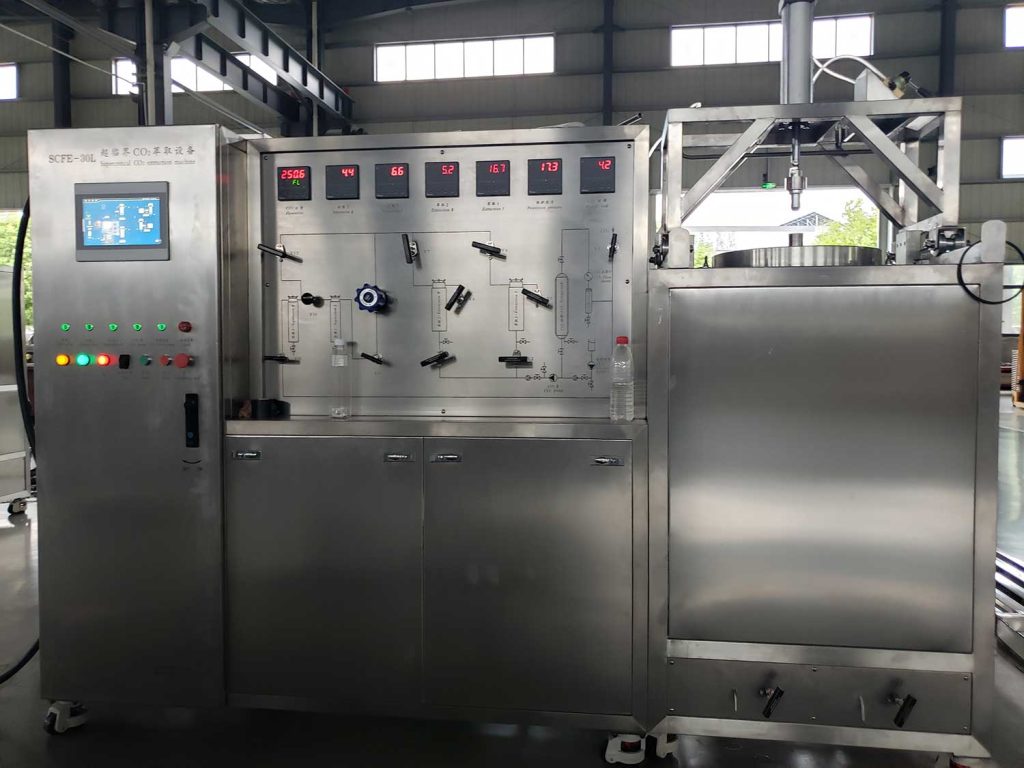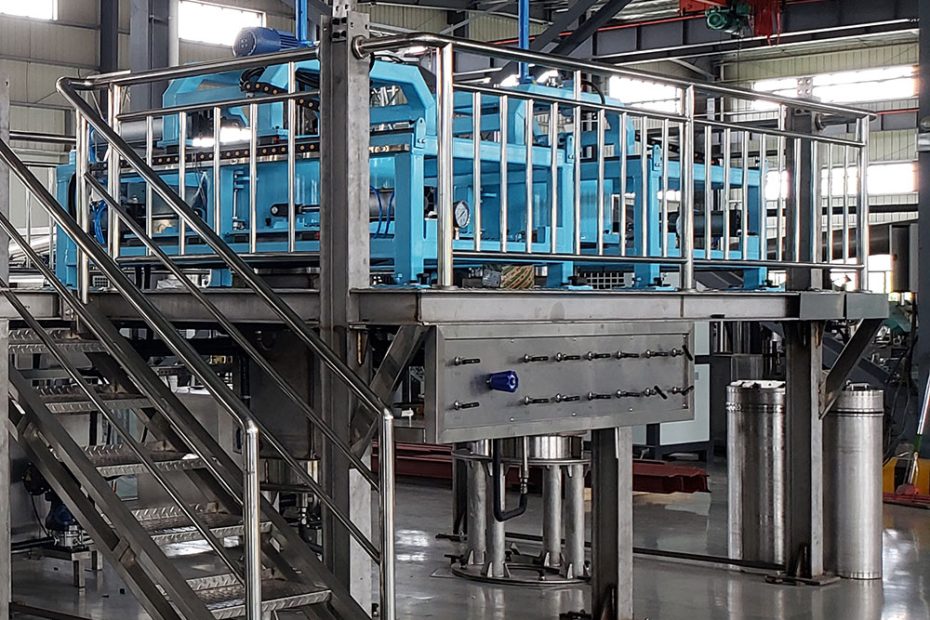Supercritical CO2 extraction is a technique that uses supercritical carbon dioxide as a solvent to extract desired compounds from raw materials such as plant matter. In the supercritical state, CO2 exhibits both gas and liquid-like properties, making it an excellent solvent for extracting delicate compounds without the need for harsh chemicals.
Supercritical CO2 (carbon dioxide) fluid extraction is a pivotal process employed in various industries, including pharmaceuticals, food, and cosmetics. The efficiency and reliability of this process often hinge on the equipment’s design, particularly the quick opening structural aspect.
Quick opening structural design of supercritical CO2 fluid extraction machine
Efficient supercritical CO2 extraction heavily relies on well-designed equipment. One critical aspect of this design is the quick opening structural feature, which allows for easy and rapid access to the extraction vessel. This design element plays a vital role in the extraction process and the overall efficiency of the equipment.
Quick opening structural design, often abbreviated as QOSD, refers to the engineering concept of creating an extraction vessel that can be swiftly opened and closed. This feature allows for convenient loading and unloading of raw materials and extracted products. QOSD enhances efficiency, reduces downtime, and improves safety during supercritical CO2 fluid extraction.
Sealing design of quick opening device
The sealing device is an important part of the high-pressure vessel for supercritical fluid extraction process . Whether the extraction kettle can operate normally and continuously depends to a large extent on the perfection of the sealing structure and the reasonable selection of sealing pressure materials.
Sealing device for small-volume supercritical CO2 extraction high-pressure vessels
Internal screw plug sealing device
The internal screw plug sealing device consists of a cylinder, a plug, a screw plug and a sealing ring. There are threads on the inner surface of the cylinder end and the outer surface of the screw plug. As long as the screw plug is screwed into the cylinder thread and the threads engage, the axial force caused by the internal pressure can be withstood. The sealing element is an O-ring. After the plug is inserted into the cylinder, the O-ring is squeezed and significantly deformed, thereby achieving the pre-tightening sealing requirement. During operation, the O-ring has a self-tightening effect under the action of internal pressure.
- The structure is simple and easy to process. There is no need to process the flange separately. The thread matching the screw plug can be directly turned out on the barrel body to reduce welds;
- The O-ring has a long service life. This is because the sealing ring does not spiral with the plug when entering the sealing position, which greatly reduces the friction and wear between it and the sealing surface, so the service life is extended;
- The plug is in contact with the medium, but the screw plug is not in contact with the medium, so the screw plug and the plug can be made of different materials;
- It is more convenient to assemble and disassemble. Since the friction distance between the O-ring and the sealing surface is small, the torque for rotating the sealing cover is greatly reduced, which significantly reduces the assembly and disassembly intensity. However, as the diameter increases, the labor intensity of unscrewing and tightening the plug also increases, so this structure is not suitable for large devices.

Triangular gasket and O-ring sealing device
The sealing structure of the high-pressure vessel in supercritical CO2 extraction equipment adopts a self-tightening sealing ring and a clamp quick-opening structure of the cylinder. It consists of a top cover, a cylinder end flange, an O-ring, a triangular gasket, a pressure ring and Composed of supporting rings and so on. The device refers to the Kazari sealing structure, and the top cover and end flange are connected with interrupted zigzag threads.
The sealing elements are triangle gasket and O-ring. The support ring is connected to the top cover through bolts to support the pressure ring and the sealing element. The O-ring is squeezed and deformed to form an initial seal. During the pressure boosting process, the pressure ring moves upward under pressure, causing the O-ring to continue to compress. deformation and achieve the purpose of self-tightening sealing. This sealing device has a simple structure, compact size, easy operation, good sealing performance, and a sealing pressure of up to 75Mpa. It has been successfully used in large-scale production equipment.
Line contact sealing structure
The line contact sealing device used in the extractor (volume 200m) of the supercritical CO2 extraction test equipment consists of an end plug, a compression screw plug, and a cylinder. The sealing structure is a forced seal and has no sealing components. There are threads on the inner surface of the cylinder end and the outer surface of the compression plug. Screw the compression screw plug into the cylinder thread and squeeze the end plug.
Since the diameter of the lower part of the end plug is slightly larger than the diameter of the boss below the thread in the cylinder, the end plug The lower part contacts the boss of the cylinder to form a line contact seal. The sealing device is characterized by high contact specific pressure, reliable sealing, and the sealing pressure reaches 70Mpa. However, because the seal is formed by the contact and extrusion of metal materials, the performance requirements for the metal materials are very high.
External screw plug sealing device
The external screw plug sealing structure is composed of an end plug, an end nut, a cylinder, a flat washer and an O-ring, as shown in Figure 3-5. There are threads on the outside of the cylinder end and the inside of the end nut. Screw the end nut into the thread on the outside of the cylinder to engage the threads, which can bear the axial force caused by the internal pressure.
Its sealing principle is similar to the sealing structure of the internal screw plug. Ruitu NOVA Company adopts this structure in its supercritical CO2 extraction test equipment separator. It uses rubber O-rings and flat washers as sealing elements. The rectangular sealing groove is opened on the cylindrical surface of the end plug, which is an extrusion type. Sealing, under the action of initial compressive stress and internal and external pressure difference, the O-ring deforms, so it has a self-tightening effect, and the sealing pressure is as high as 70Mpa
O-ring sealing structure
The sealing structure of the extractor in the small supercritical CO2 extraction test equipment. This structure uses polytetrafluoroethylene plastic O-ring as the sealing element. The rectangular sealing groove is opened on the end face of the cylinder and the flat end cover.
The annular protrusion with a rectangular cross-section presses against the sealing element in the rectangular groove, causing the sealing element to deform under the action of a large pre-tightening force and fill the rectangular sealing groove, thus forming a reliable seal. It can be seen that although these high-pressure sealing structural forms can form reliable seals, their application scope is greatly limited due to strict requirements on processing and materials.
Advantages of QOSD in supercritical CO2 fluid extraction machine
- Time Efficiency: QOSD enables rapid access to the extraction vessel, reducing downtime between batches and increasing overall throughput.
- Improved Safety: Quick and controlled access enhances safety by minimizing exposure to high-pressure CO2, reducing the risk of accidents.
- Enhanced Maintenance: QOSD simplifies equipment maintenance, allowing for thorough cleaning and maintenance of internal components.
- Versatility: This design feature accommodates various vessel sizes and shapes, making it suitable for a wide range of applications.
Conclusion
Quick opening structural design is a fundamental element in the development of efficient and safe supercritical CO2 fluid extraction. This design feature is instrumental in various industries, including pharmaceuticals, food and beverages, cosmetics, and herbal extraction, where time efficiency, safety, and versatility are paramount.
As technology continues to advance, the incorporation of QOSD in supercritical CO2 extraction machine ensures that the extraction process remains a cornerstone of modern industrial processes. This design innovation enhances productivity, reduces downtime, and promotes the sustainable and responsible use of natural resources.
